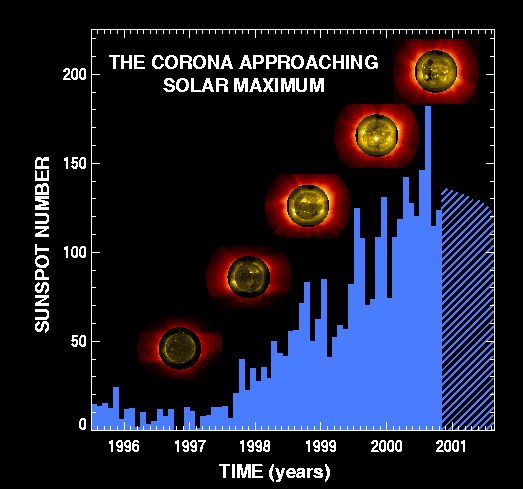The Corona Approaching Solar Maximum
|
Click on the image below for a larger version
Also available: a postscript image (6 Megabytes) formatted for 8.5 by 11 inch paper. |
 |
| Quantitative changes in the solar corona as seen by UVCS/SOHO from 1.5 to 3.5 solar radii and by EIT/SOHO at lower heights during the rising phase of solar cycle 23. The five solar images from left to right are composites of UVCS/SOHO O VI 1032 Å (outer) and EIT/SOHO 284 Å (inner) synoptic images. The center of each solar image is positioned above the date of observation. The blue histogram represents the National Solar Observatory/Sacramento Peak sunspot numbers (monthly averages). The hatched blue region corresponds to predictions of future sunspot numbers from the Marshall Space Flight Center Solar Physics Branch. Both the UVCS and EIT instruments are calibrated, so the color scales represent the measured brightnesses of their respective sections of the composite image. However, the brightest portion of the EIT images is about 10,000 times larger than the brightest portion of the UVCS images. In each case, brightnesses increase from the black region through the red or yellow regions to the white regions. |
Caption: The corona is the Sun's outer atmosphere. The corona has bright emission at ultraviolet wavelengths. The O VI emission shown above comes from coronal oxygen atoms that have five missing electrons. Artificial eclipses produced by UVCS block out the disk of the Sun and filter out everything except the O VI 1032 Å emission. UVCS scans the entire corona in a ``synoptic'' sequence. For this standard observation, the UVCS instrument observes a narrow rectangle in the solar corona that is 40 arcminutes long and 84 arcseconds wide. The rectangle can be scanned in height at each of eight position angles around the Sun. The images are made by interpolating between positions to provide complete coverage between the inner and outer heights. The above composites have been generated from five UVCS/SOHO and EIT/SOHO synoptic images taken in December 1996, December 1997, December 1998, December 1999, and October 2000, covering over four years of SOHO's operation in the current solar cycle. The histogram (blue) shows the number of sunspots from mid-1995 through September 2000. For dates after October 2000, a prediction from the MSFC Solar Physics Branch is provided. The corona displays a variety of features including coronal holes and streamers. In the above images, those features and the overall shape and brightness of the corona can be seen changing with the sunspot activity cycle. From solar minimum in 1996 to mid-1998, the large scale configuration of the corona consists of dark coronal holes over the north and south heliographic poles and quiescent streamers at the equator. Toward solar maximum, there is a striking difference in the appearance of the corona. The streamers fill more of the coronal volume, and the extended corona and disk become considerably brighter.
One way of tracking the solar activity is by observing sunspots. Sunspots are relatively cool areas that appear on the face of the Sun. During solar minimum there are only a few sunspots, and during solar maximum there are about 20 times more spots. Every 11 years the Sun undergoes a period of activity called solar maximum followed by a quiet period called solar minimum. The sunspot number is calculated by first counting the number of sunspot groups and then the number of individual sunspots. The ``sunspot number'' is then given by the sum of the number of individual sunspots and ten times the number of groups. Although sunspots themselves produce only minor effects on solar emissions, the magnetic activity that accompanies the sunspots can produce dramatic changes in the ultraviolet and soft X-ray emission levels. These changes over the solar cycle have important consequences for the Earth's magnetosphere and upper atmosphere.
Links:
Picture Credit: Smithsonian Astrophysical Observatory; ESA & NASA
Image processing/comments:
Mari Paz Miralles (mmiralles@cfa.harvard.edu),
Alexander Panasyuk, Raid Suleiman, Steven Cranmer and John Kohl.
Instrument/observatories: UVCS/SOHO (Ultraviolet Coronagraph Spectrometer); EIT/SOHO
(Extreme ultraviolet Imaging Telescope); NSO/SP (National Solar Observatory/Sacramento Peak);
MSFC (Marshall Space Flight Center) Solar Physics Branch.


